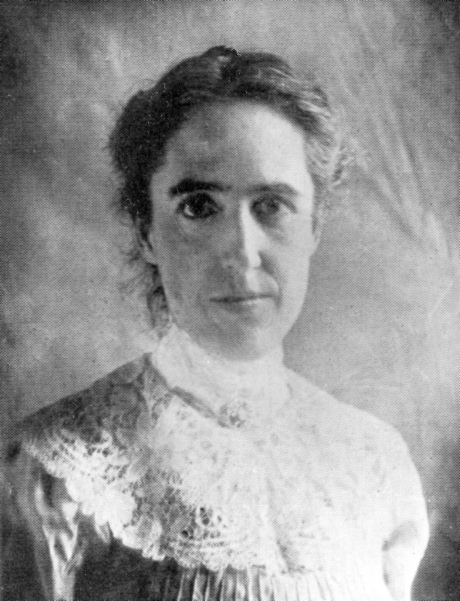- Henrietta Swan Leavitt
Infobox Scientist
name = Henrietta Swan Leavitt
box_width =
image_width =163px
caption = Henrietta Swan Leavitt
birth_date =July 4 1868
birth_place =
death_date =December 12 1921
death_place =
residence =
citizenship =
nationality =United States
ethnicity =
field =astronomy
work_institutions =
alma_mater =
doctoral_advisor =
doctoral_students =
known_for =
author_abbrev_bot =
author_abbrev_zoo =
influences =
influenced =
prizes =
religion =
footnotes =
Henrietta Swan Leavitt (July 4 1868 –December 12 1921 ) was an Americanastronomer , and thedeaf [cite web|url=http://www.mada.org.il/website/html/eng/2_1_1-31.htm|title=Henrietta Swan Leavitt, A deaf, female scientist—over 100 years ago!|accessdaymonth=18 May|accessyear=2007|publisher=Bloomfield Science Museum, Jeruselem] daughter of aCongregational church minister. [cite news|url=http://www.csmonitor.com/2005/0705/p15s01-bogn.html|title=Before computers, there were these humans...|publisher=Christian Science Monitor|author=Gregory M. Lamb|date=July 5, 2005|accessdate=2007-05-18] She was born inLancaster, Massachusetts to an old Massachusetts Puritan family who had settled in the Massachusetts Bay Colony in the early part of the seventeenth century. (The family name was originally spelled Levet orLevett in early Massachusetts records.) She attendedOberlin College , and graduated fromRadcliffe College (then called the Society for the Collegiate Instruction for Women) with an A.B. degree in 1892.Leavitt began work in 1893 at
Harvard College Observatory as one of the women "computers" brought in byEdward Charles Pickering to measure and catalog the brightness of stars in the observatory'sphotographic plate collection. (In the early 1900s, women were not allowed to operate telescopes. [ [http://www.exploratorium.edu/origins/hubble/people/supernovas.html Exloratorium note] ] ) She noted thousands ofvariable star s in images of theMagellanic Clouds . In 1908 she published her results in the "Annals of the Astronomical Observatory of Harvard College," noting that a few of the variables showed a pattern: brighter ones appeared to have longer periods. After further study, she confirmed in 1912 that the variable stars of greater intrinsicluminosity —actuallyCepheid variables —did indeed have longer periods, and the relationship was quite close and predictable.This relationship provided an important yardstick for measuring distances in the
Universe , if it could be calibrated. One year after Leavitt reported her results,Ejnar Hertzsprung determined the distance of several Cepheids in theMilky Way , and with this calibration the distance to any Cepheid could be determined.At the time, it was not clear that millions of (what we now call) galaxies were actually outside of the Milky Way. Their distance could not be measured until a tool existed. Cepheids were soon detected in other galaxies such as the
Andromeda Galaxy (notably byEdwin Hubble in 1923-4). Cepheids were an important part of the evidence that galaxies are far outside of the Milky Way. Our picture of the universe was changed forever, largely because of Leavitt's discovery.Leavitt worked sporadically during her time at Harvard, often sidelined by health problems and family obligations. But by 1921, when
Harlow Shapley took over as director of the observatory, she was head of stellar photometry. She succumbed to cancer by the end of that year and was buried in the family plot at Cambridge Cemetery in Cambridge, Massachusetts."Sitting at the top of a gentle hill," writes George Johnson in his biography of Leavitt, "the spot is marked by a tall hexagonal monument, on top of which (cradled on a draped marble pedestal) sits a globe. Her uncle Erasmus Darwin Leavitt and his family are also buried there, along with other Leavitts. A plaque memorializing Henrietta and her two siblings who died so young, Mira and Roswell, is mounted directly below the continent of Australia. Off to one side, and more often visited, are the graves of Henry and
William James ."Awards and honors
* The
asteroid 5383 Leavitt and the Leavitt crater on theMoon are named in her honour.
* Four years after her death, the Swedish mathematicianGösta Mittag-Leffler considered nominating her for the 1926 Nobel prize in physics, and wrote to Shapley requesting more information on her work on Cepheid variables, offering to send her his monograph onSofia Kovalevskaya . Shapley replied, suggesting that the true credit belonged to his "interpretation" of her findings. She was never nominated, and the Nobel Prize is not awarded posthumously. [Johnson, pp.118-9] [ [http://membership.acs.org/c/chicago/WCC/leavitt.html ACS bio] ]Notes
References
*cite book | author=Johnson, George | title=Miss Leavitt's Stars: The Untold Story of the Woman Who Discovered How to Measure the Universe | publisher=New York: W.W. Norton & Company | year=2005 | id=ISBN 0-393-05128-5
* Lorenzen, Michael (1997). "Henrietta Swan Leavitt." In "Notable Women in the Physical Sciences: A Biographical Dictionary". Edited by Barbara and Benjamin Shearer. Westport, CT: Greenwood Press, 233-37. ISBN 0-313-29303-1.External links
* [http://www.astrosociety.org/education/resources/womenast_bib02.html#3h Bibliography] from the
Astronomical Society of the Pacific
* [http://cwp.library.ucla.edu/articles/leavitt/leavitt.note.html Periods Of 25 Variable Stars In The Small Magellanic Cloud.] Edward C. Pickering, March 3, 1912; credits Leavitt.
* [http://membership.acs.org/c/chicago/WCC/leavitt.html Henrietta Swan Leavitt: a Star of the Brightest Magnitude] ACS Bio with several links
Wikimedia Foundation. 2010.
